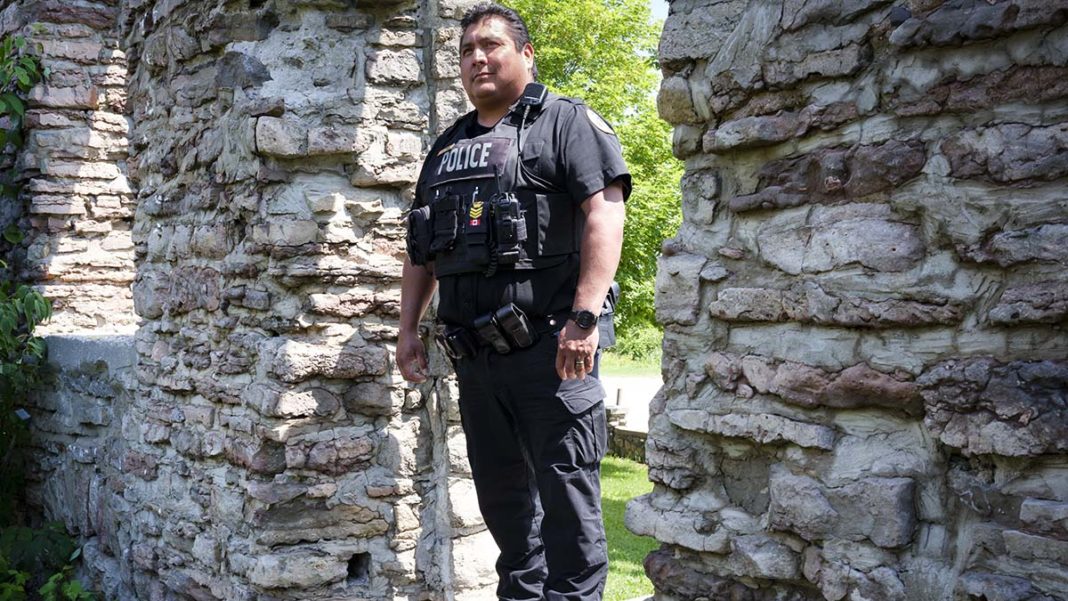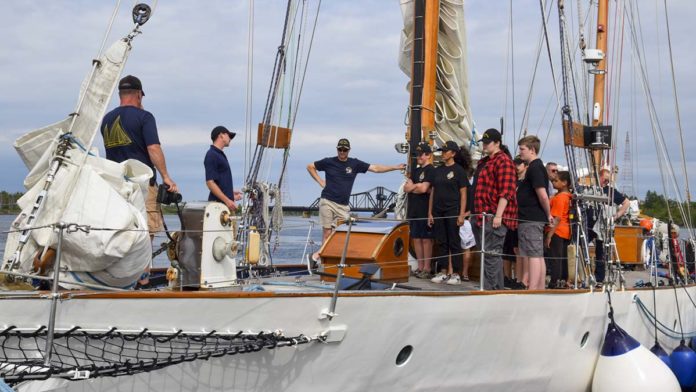WIIKWEMKOONG—Wikwemikong Tribal Police Service (WTPS) and NOSM University researchers are working together to develop a culturally-based, trauma-informed policing approach for Indigenous police services. The $1,120,500 project will take a wholistic approach involving persons who experience trauma or crimes as well as responding police officers and perpetrators.
“There’s no existing comprehensive training for Indigenous police for trauma-informed policing,” said WTPS Staff Sergeant Scott Cooper. “Healing is rarely focused on the persons who report a crime or who experience a crime, and it’s rarely focused on the officers and the staff people in the police department.”
There is nothing that can support the police service through the entire process of what they’ve been through when investigating horrific crimes, he added. “A lot of times those officers themselves have experienced some of the adverse childhood experiences and that really affects them on their job.”
Dr. Marion Maar, a professor at NOSM, had done work in Wiikwemkoong based on land-based activities and cultural aspects. Staff Sergeant Cooper approached her and they came up with the idea to develop a new policing approach. Dr. Maar’s previous work on opioids in Wiikwemkoong found that adverse childhood experiences were quite severe in people who were in treatment. They used findings from that collaboration on opioids to inform this project.
Adverse childhood experiences could be many different things, Dr. Maar explained. This could be having a parent go to jail, witnessing violence, suffering sexual abuse, physical abuse, one parent being absent, or a range of similar experiences. “Everyone as a child, and also later on, will have adverse experiences. We know that. It’s not just First Nations or rural people, everyone has them.”
The more adverse childhood experiences someone has, the more they will be affected. “Basically it becomes compounding,” Dr. Maar said. “Adverse childhood experiences can affect your mental health as an adult. It’s a predictor for addictions but even physical health, say diabetes or heart disease. All those things can be predicted by these adverse childhood experiences. One of the reasons being is if you are, as a child, very often in this state of being afraid for your life or your safety, it triggers your nervous system to respond really quickly. It puts your nervous system in a state of hyper-arousal so you are always in a flight or fight or maybe even freeze response. Then, as you’re getting older, your biology can just be triggered by that.”
It’s hard to know what’s going to trigger someone. Something from their past that could trigger them but without knowing their background, you won’t know what their trigger is. Intimate partner violence witnessed as a child could trigger that person as an adult, and they may not even really realize. Their nervous system can get triggered and flooded. “We know there’s a whole host of things that could happen and it’s about learning to identify that: what are your triggers and then how to deal with them. Once you become aware, you’re not just driven by your biology,” Dr. Maar explained. “When you’re afraid, you can’t necessarily talk yourself out of being afraid or out of being angry to a certain response but you can do things to improve your response. Things like being aware and then doing things like land-based activities. It’s actually now becoming more and more scientifically proven that land-based activities, dancing, working with your hands, doing crafts and so on, actually work to quieten your nervous system.”
The project will combine those things with cultural teachings and time with elders, time with healers and knowledge keepers and other activities.
“This whole process of trauma-informed policing is focused on a person’s strengths, not their deficits,” said Staff Sergeant Cooper. “One of the strengths that we see in Indigenous culture is the ability to be sad or to cry. At one time, warriors were able to mourn the loss of loved ones, the loss of family or friends and they would go out and do a lot of things, one would be cut their hair. That’s why it’s so traumatic that when a lot of children were taken to residential schools, they cut their hair.”
Crying now invokes shame but in pre-colonial times it was seen as a strength to be vulnerable in order to heal, he said. “They would go out and do ceremonies. They would do things on the land to help heal themselves. They’d pray. They’d sing and they’d learn how to do these drumming activities. We can learn from those things and that’s what this approach is about, re-learning a lot of those things, taking from the past and bringing them forward. It is essentially walking backwards into the future by understanding what those strengths were and making them back into strengths again.”
A lot of times when young people have experienced crimes and don’t get the supports they need, they can end up having substance abuse behaviours and getting in trouble with the law, and losing family, Staff Sergeant Cooper said. “They’re trying to numb that pain they don’t know how to deal with. This approach focuses on that personal strength, the social and community networks of the Anishinaabe people here. If Anishinaabe heritage is to be understood as a strength then the police insights, the concepts, the ideas, the values and the codes must be studied and fully understood and there’s no better way to understand this than by examining those ceremonies, talking to elders about some of the rituals and the prayers, learning about some of the songs and the dancing, learning about arts and crafts and the land-based activities and hearing their stories and hearing the stories from our elders and our knowledge keepers. It’s important because it is all what we believe about life and being and existence.”
The relationships Anishinaabe people have with ceremonies and the rituals, prayers, songs, arts and crafts, land-based activities and the stories are symbolic and they’re symbolically expressed through their way of life, he continued. “This has ensured our survival for thousands of years. Essentially these truths need to be part of ourselves. Understanding this way of life is also understanding the impact trauma has on one person’s health so what we’d like to do is braid these together through like a Western view of policing and traditional view of how we would deal with trauma and moving forward. That’s what this is, the operation of policing and braiding it all together into a new, useful process that could be shared with other Indigenous police services and municipal police services that are providing services to Indigenous communities.”
NOSM University researchers are excited about working across the disciplines, Dr. Maar said. “If there is a call that involves mental health or violence or addiction, what can each sector contribute and how can we train together to respond better? If you’re working with somebody who’s been traumatized there are biological reasons why they won’t remember right away, so if you’re interviewing victims, there’s a different victim interviewing style that needs to be considered. Victims will at times sound like what we think of as unreliable witnesses but that’s just part of the biology.”
The project will not only look at how all sectors can work together with police to figure out the best way of interviewing somebody who has just experienced violence, but how to work with police officers who are experiencing vicarious trauma. “How can we proactively learn more about traditionally what have Indigenous people used to keep those people who are safeguarding the community, who are warriors, healthy? What is culturally appropriate?”
“We’re all survivors and we’re all progressing through life,” Staff Sergeant Cooper said. “What we need to do is braid those things together because there are benefits from Western culture and we also have lots of benefits and strengths in our own culture. I think if we weave them together it could create wonderful things.”




